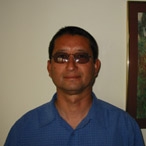
School:
Grade Level:
Teaching Position:
Supervisor:
Department:
Mentor:
Research Project Year:
Research Project Title:
Research Project Description:
This research project evaluated proton diffusion rates in ice based on density of deuterated water(D2O) and H2O. Diffusion studied in this experiment was on the atomic level, i.e. protons of hydrogen atoms hopping or transferring from one H2O molecule to another, in a polycrystalline environment<97>ice. The proton transfer is a random process which leads to diffusion of the protons. It is commonly believed that proton transfer takes place in ice without the introduction of a stimulus into the environment. If this is true, then the outcome of this experiment should show that proton transfer/proton diffusion will occur in samples of ice made from deuterated water (D2O) fused with ice made from pure H2O and stored at <96>20° C during the length of the experimental run. The ice cell formed was divided into one centimeter sections and the density of each section calculated. If proton diffusion occurred, there would be changes in density of the former place of D2O and the former place of H2O, the region where the heavy water used to have been decreasing in density as the region where the pure water used to have been increases in density, beginning at the interface of fusion of the two ice cells and diffusing over time throughout the sample.
Research Project Attachments:
| Attachment | Size |
|---|---|
| 206.17 KB |
Curriculum Project Year:
Curriculum Project Title:
Curriculum Project Description:
My goal was to develop a standards aligned unit that incorporates some of the tools I used during my RET1 experience. During that experience, my mentor encouraged me to <93>write down everything,<94> dates, times, data, observations, diagrams, questions, and thoughts in a logbook. Data was then transferred to a spreadsheet program where it was organized, analyzed, and graphed. For this unit I have chosen several activities that allow for the same process to be imitated. Students will keep a running log of their activities. Students will set-up an Microsoft Excel spreadsheet and use it to organize, analyze, and represent the data in graphs. In addition, I have tapped resources from the Internet, the county education office, and a local teacher resource center. Students will use a bridge-building program downloaded from the Internet, view videos from the Santa Barbara County Education Office that address specific standards, engage in rocket building activities from the NASA Teacher Resource Center located in Lompoc at Vandenberg Air Force Base. Finally, work and activities throughout the unit, some of which students will document with a digital camera, will culminate in student created Microsoft PowerPoint presentations shown to the class. The unit spans about fourteen weeks and addresses the standards for grade 8<97>Motion 1a-f and Forces 2a-g. The unit will include numerous hands-on discovery and inquiry labs.
Curriculum Project Attachments:
| Attachment | Size |
|---|---|
| 1.04 MB |
